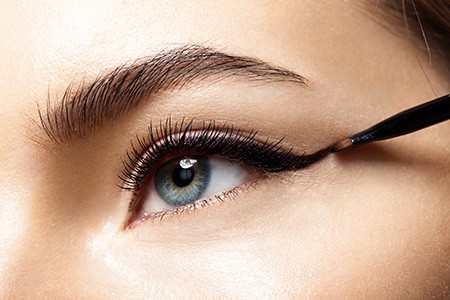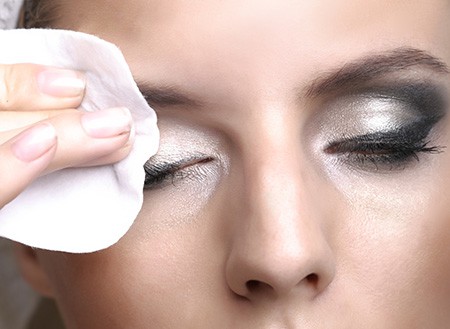
Eye and face cosmetics and skin care products can cause eye irritation. Dry eye disease affects more women than men, and people who use makeup are primarily women, so there may be a connection between dry eyes and makeup. Research shows eye makeup can contaminate the tear film and clog the meibomian glands, causing dry eye symptoms. Makeup may even decrease the effect of some dry eye treatments.
Laser Eye Center™ offers dry eye treatments at our six locations in Los Angeles County, Santa Clarita Valley, and Inland Empire. Our dry eye specialists are at the top of their field and offer the latest options for dry eyes, such as BlephEx and iLux.
Eye Cosmetics and Tear Film
Healthy, lubricated eyes rely on a balanced tear film made of three components:
- Oil: Meibomian glands lining the lower and upper eyelids secrete nourishing meibum or lipids to provide the oily layer of tears.
- Water: Aqueous or water tears are made in the lacrimal gland above the outer eyes.
- Mucous: Mucin is released from conjunctival goblet cells (the membrane lining the front of the eye and eyelids) and contains mucins, water, and electrolytes.
A 2018 review published in Clinical Optometry studied how cosmetic products move across the eyelid margin and worsen tear film instability and dry eye symptoms. Women with dry eyes have reported complications with inflammation and eye or eyelid discomfort while wearing makeup, and the research showed it may come down to how and where eyeliner is applied on the eyelid.
When eyeliner is drawn on the inner edge of the eyelids or inner eyelash line, it’s more likely to be associated with tear film disruption or contamination. Women experience less eye discomfort when eyeliner is applied to the outer eyelid skin above the upper eyelashes or below the lower eyelashes.

Eye makeup can clog the meibomian glands and cause dry eyes by disrupting the tear film and causing rapid tear evaporation and eyelid inflammation. However, removing makeup and cleansing the eyelids can improve symptoms.
Most research focuses on eyeliners and dry eye disease. Other cosmetic products can destabilize the tear film, including facial creams, some cleansers, mascara, and loose powder for the face and eyes.
Wearing eye makeup can compromise how well dry eye treatments work, with some research showing liposomal sprays and lipid-containing eye drops causes more eye cosmetics to cross into the eyelids and glands.
Makeup Tips for Dry Eyes
Dry eye disease doesn’t mean you can never wear makeup. There are several ways to adjust your beauty routine and improve your dry eye symptoms, including:
- Only use products approved by the Food and Drug Administration (FDA), which are tested for safety and require specific labeling.
- Wash your hands and face before applying your makeup.
- Never share your eye makeup with friends or family, including makeup brushes and eyelash curlers. (To prevent eye infections stemming from bacteria or fungus, avoid using makeup testers at beauty stores.)
- If possible, avoid wearing eyeliner because of the link to dry eye and meibomian gland dysfunction. If you must wear eyeliner, apply it to the outside of the lash line to prevent makeup particles from affecting the eyelid glands and tear film.
- All eye makeup expires after three months of use; discard when that time is up.
- Use cream-based eyeshadow, foundation, and highlighter to prevent glitter and powder from entering your eyes.
- Avoid eyelash extensions and fake eyelashes because they can aggravate swollen eyelids, and tubes of eyelash glue contain formaldehyde that dries the ocular surface.
- Wash makeup brushes every seven to 10 days or more often to eliminate dirt, oil, and bacteria from the bristles.
- Replace all eye makeup after an eye infection.
- Remove makeup entirely at the end of the day.
How to Properly Remove Eye Makeup
Always remove your eye and face makeup before bed to stop the products from leaking into your eyes. Rubbing your eyes with your hands or into your pillow while you sleep will worsen dry eye symptoms and introduce makeup particles into the eyes.
Many women use makeup removers as part of their nighttime routine, but make sure the product you’re using to remove your makeup doesn’t contain oil or parabens that irritate the eyes. Don’t use exfoliating scrubs around the eyes or any cleanser with a gritty texture that may cause eye discomfort or scratch your eyes.

Vaseline is an effective makeup remover that lubricates the skin and wipes away makeup without pulling or tugging the skin. You can wash your eyelids and eye area with tear-free baby shampoo to improve eyelid inflammation and meibomian gland function.
These tips will help you remove your eye cosmetics thoroughly:
- Avoid getting eye makeup remover in your eyes and focus on gentle movements away from the eye’s surface.
- Rinse off the remover completely once the eye makeup is gone.
- Use a clean cotton swab to brush along the base of the eyelashes to ensure all makeup is washed off.
- Be gentle with your eyelid tissues and eyelashes. Eyelashes help keep dirt and dust out of the eyes and block air from drying the tear film. Damaging the eyelashes could do more harm.
Learn More About Dry Eyes and Treatment Options at Laser Eye Center™
These tips and information about makeup causing dry eyes may help improve your symptoms. Many people require a combination of dry eye treatments and lifestyle changes for long-term relief. Schedule an eye exam and dry eye consultation at Laser Eye Center™ to learn more about dry eyes. Call our SoCal locations in Los Angeles County, Santa Clarita Valley, and Inland Empire at (800) 649-2659 to book an appointment today.
SOURCES:
- https://www.dryeyeandme.co.uk/can-you-wear-makeup-when-you-have-dry-eye/
- https://www.optometrists.org/general-practice-optometry/guide-to-eye-health/using-eye-makeup-safely/
- https://www.ncbi.nlm.nih.gov/pmc/articles/PMC6118859/
- https://www.aao.org/eye-health/tips-prevention/eye-makeup
Schedule your free consult today
Click here to learn moreGet started on your journey to clearer, crisper vision with Laser Eye Center™. Our expert team of doctors are trained and skilled in the latest technology and methods for laser vision correction. To learn more about our state-of-the-art All Laser LASIK technology or about All Laser LASIK itself, contact us today. Schedule your FREE All Laser LASIK consultation by calling today.

